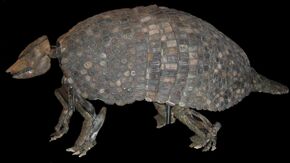Biology:Holmesina
| Holmesina | |
|---|---|

| |
| Fossil skeleton of H. septentrionalis | |
| Scientific classification | |
| Domain: | Eukaryota |
| Kingdom: | Animalia |
| Phylum: | Chordata |
| Class: | Mammalia |
| Order: | Cingulata |
| Family: | †Pampatheriidae |
| Genus: | †Holmesina Simpson 1930 |
| Species | |
| |
Holmesina is a genus of pampathere, an extinct group of armadillo-like xenarthrans that were distantly related to extant armadillos. Like armadillos, and unlike the other extinct branch of megafaunal cingulates, the glyptodonts, the shell was made up of flexible plates which allowed the animal to move more easily. Holmesina species were herbivores that grazed on coarse vegetation; armadillos are mostly insectivorous or omnivorous.[2]
Holmesina individuals were much larger than any modern armadillo: They could reach a length of 2 metres (6.6 ft), and a weight of 227 kilograms (500 lb), while the modern giant armadillo does not attain more than 54 kilograms (119 lb).[3]
Distribution
They traveled north during the faunal interchange, and adapted well to North America, like the ground sloths, glyptodonts, armadillos, capybaras, and other South American immigrants. Their fossils are found from Brazil to the United States,[4] mostly in Texas and Florida.
References
- ↑ Moura, J. F.; Gois, F.; Galliari, F. C.; Fernandes, M. A. (2019). "A new and most complete pampathere (Mammalia, Xenarthra, Cingulata) from the Quaternary of Bahia, Brazil". Zootaxa 4661 (3): 401–444. doi:10.11646/zootaxa.4661.3.1. PMID 31716695.
- ↑ Vizcaíno, S. F.; De Iuliis, G.; Bargo, M. S. (1998). "Skull Shape, Masticatory Apparatus, and Diet of Vassallia and Holmesina (Mammalia: Xenarthra: Pampatheriidae): When Anatomy Constrains Destiny". Journal of Mammalian Evolution 5 (4): 291–322. doi:10.1023/A:1020500127041.
- ↑ "Yahoo! Groups". https://groups.yahoo.com/neo/groups/CenozoicLife/conversations/topics/149.
- ↑ "Holmesina Simpson 1930". Paleobiology Database. http://www.fossilworks.org/cgi-bin/bridge.pl?a=taxonInfo&taxon_no=43540.
Further reading
- J. C. Cisneros. 2005. New Pleistocene vertebrate fauna from El Salvador. Revista Brasileira de Paleontologia 8(3):239-255
- P. J. Gaudioso, G. M. Gasparini, and R. M. Barquez. 2016. Paleofauna del Pleistoceno de Termas de Rio Hondo, Santiago del Estero, Argentina. Ameghiniana 53(6):54-54
- J. I. Mead, S. L. Swift, R. S. White, H. G. McDonald, and A. Baez. 2007. Late Pleistocene (Rancholabrean) glyptodont and pampathere (Xenarthra, Cingulata) from Sonora, Mexico. Revista Mexicana de Ciencias Geológicas 24(3):439-449
Wikidata ☰ Q140865 entry
 |



